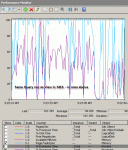Rx_
Nothing In Moderation
- Local time
- Yesterday, 23:14
- Joined
- Oct 22, 2009
- Messages
- 2,803
Any ideas would be appreciated on why a simple query takes 7 seconds to respond?
Upsized the Access 2010 back-end to SQL Server 2008. Running one copy of Access 2010 Front end to a SQL Server DB and one Copy of the same Access 2010 Front-end to the Access 2010 DB (back end).
A form uses a query to open the first main screen that allows the user to select a Well.
On Access to Access it opens really fast.
On Access to SQL Server - it takes a grueling 7 seconds.
Created a View in SQL Server with the exact same query - It is under a second, but still not as fast.
We are not talking complex queries or large tables (see attachment).
Went to SQL Server and removed all indexes for these tables. Nothing changed. Changed SQL to Simple Recovery.
The ODBC driver is SQL Server for the SQL version.
SQL Server Version is RTM 10.50.1600.1 - no SP 1, 2, or 3.
The SQL Manager appears to run the view very fast for what that is worth.
Just a final note: The solution was posted below. However, this query (see red arrows) while improved is still unacceptable. This somewhat surprised me. The Access 2010 engine was expected to communicate with SQL Server 2008 more efficiently. So, as noted below - this will be converted to a View in SQL Server. The Linked Table to this View returns records much, much faster.
Upsized the Access 2010 back-end to SQL Server 2008. Running one copy of Access 2010 Front end to a SQL Server DB and one Copy of the same Access 2010 Front-end to the Access 2010 DB (back end).
A form uses a query to open the first main screen that allows the user to select a Well.
On Access to Access it opens really fast.
On Access to SQL Server - it takes a grueling 7 seconds.
Created a View in SQL Server with the exact same query - It is under a second, but still not as fast.
We are not talking complex queries or large tables (see attachment).
Went to SQL Server and removed all indexes for these tables. Nothing changed. Changed SQL to Simple Recovery.
The ODBC driver is SQL Server for the SQL version.
SQL Server Version is RTM 10.50.1600.1 - no SP 1, 2, or 3.
The SQL Manager appears to run the view very fast for what that is worth.
Just a final note: The solution was posted below. However, this query (see red arrows) while improved is still unacceptable. This somewhat surprised me. The Access 2010 engine was expected to communicate with SQL Server 2008 more efficiently. So, as noted below - this will be converted to a View in SQL Server. The Linked Table to this View returns records much, much faster.
Attachments
Last edited:


